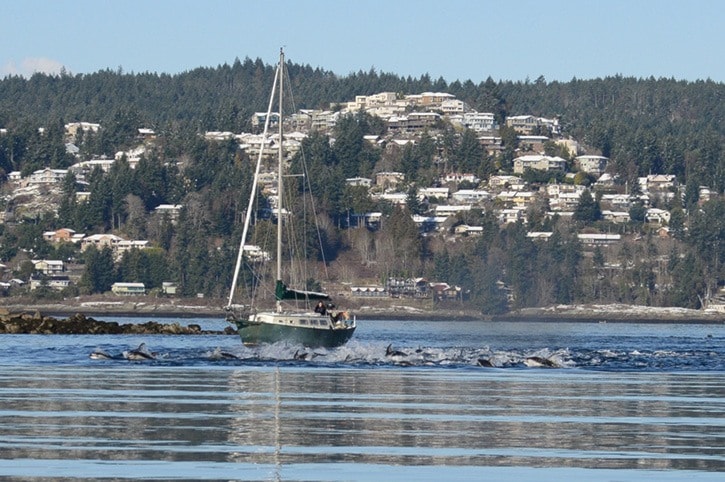Nature presented a unexpectedly graphic spectacle for anyone on the waters or the shores of Departure Bay Monday when killer whales rounded up a pod of dolphins for a meal.
The animals' activity played out over a span of nearly three hours starting at about 10:15 a.m. when a pod of an estimated 100 Pacific white-sided dolphins rushed into Departure Bay.
The event was a rare opportunity for cetacean researchers at Nanaimo's Pacific Biological Station who watched the beginnings of the drama unfold from their office windows.
"We suspected right away that they were being chased in by killer whales because of their really tightly-packed group and the way they were behaving, going back and forth in the bay in an agitated state," said John Ford, head of the Cetacean Research Program at the biological station. "We've seen killer whales attacking dolphins in other places before and this is typically what happens."
It was after 11 a.m. when researchers were notified that a pod of about eight orcas had entered the bay, at which point Ford and a research team took a boat out on the bay to record the event and gather data.
The hunting orcas were a pod of about eight Bigg's Killer Whales, otherwise known as transient killer whales that typically feed on smaller marine mammals, such as harbour seals, sea lions, harbour porpoises, white-sided dolphins and sometimes even minke whales.
"We don't know how many [dolphins] they ate," Ford said. "We know that they ate at least two. We've got little bits of tissue that were floating and we might have to do some DNA fingerprinting to see how many individuals were there."
Suspected remains from a Dall's porpoise were found as well.
Dall's porpoise are common in Georgia Strait and are on the Bigg's killer whale menu, but aren't known to swim with Pacific white-sided dolphins, so the find came as somewhat of a surprise to the research team.
"It was definitely exciting," Ford said. "Lots of people here at the biological station were looking out their windows or from down on the waterfront, seeing it all happen."
Ford said, after the killing, employees at the station saw some of the dolphins swim past as they escaped back into the strait shortly after 1 p.m. Others fled through Newcastle Channel and were spotted passing by the Dinghy Dock Pub.
The killer whale's hunting strategy is to work as a pod to herd animals into shallow bays and confuse and even stun animals to make their kills.
The pod of dolphins in Monday's incident wasn't particularly large. Ford said dolphin numbers have been on the rise overall. Pacific white-sided dolphins started moving into Georgia Strait around 1990, possibly driven in by competition from groups elsewhere. Their numbers in the strait have risen ever since, possibly because of an abundance of herring and other food species.
Ford said there have been recent sightings of groups of 500 to 1,000 animals in Georgia Strait and pods of up to 2,000 dolphins have been seen around Haida Gwaii.
"They're big-schooling dolphins that often travel in big groups," Ford said.
Monday's orca hunt was the first ever recorded in Departure Bay and Ford figures it could be a long time before anything like that happens there again.
"I would be really surprised to see something like this happen again any time soon," Ford said. "It's a fairly rare event. I've only seen this kind of predation maybe four or five times in my 30 years of watching killer whales on this coast," Ford said. "Folks were pretty fortunate to see it right from the ferry and the shore here."
